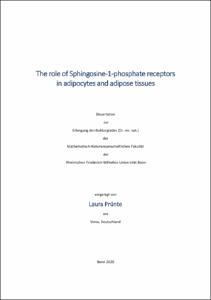Prünte, Laura: The role of Sphingosine-1-phosphate receptors in adipocytes and adipose tissues. - Bonn, 2021. - Dissertation, Rheinische Friedrich-Wilhelms-Universität Bonn.
Online-Ausgabe in bonndoc: https://nbn-resolving.org/urn:nbn:de:hbz:5-61002
Online-Ausgabe in bonndoc: https://nbn-resolving.org/urn:nbn:de:hbz:5-61002
@phdthesis{handle:20.500.11811/8883,
urn: https://nbn-resolving.org/urn:nbn:de:hbz:5-61002,
author = {{Laura Prünte}},
title = {The role of Sphingosine-1-phosphate receptors in adipocytes and adipose tissues},
school = {Rheinische Friedrich-Wilhelms-Universität Bonn},
year = 2021,
month = jan,
note = {Obesity is a worldwide health issue with increasing numbers of patients every year. Moreover, the prevalence of obesity gives rise to related cardiovascular diseases and various other comorbidities influencing quality of life and burdening the healthcare systems. To date no pharmacological therapy exists to treat obesity. Therefore, new biological targets for therapy of the obesity pandemic are extensively searched for. In recent years brown adipose tissue has attracted attention in the scientific community due to its ability to burn calories in form of fat and transform them into heat. Activation of brown adipocytes or transformation of white adipocytes into ‘brown-like’ beige adipocytes could be a new way of treating excess overweight.
Sphingosine-1-phosphate (S1P) is a versatile biological messenger involved in a plethora of physiological functions. It agonizes five different G protein-coupled Sphingosine-1-phosphate receptors (S1PRs) which are broadly expressed throughout human and murine tissues. The role of S1P in the immune system is already quite well elucidated whereas the knowledge about the role of S1P in obesity is still in its infancy.
This study broadly investigates the role of S1P and S1PRs in brown and white adipocytes, as well as in adipose tissues and attempts to give an overview of the different most important S1PRs, their function and their downstream signaling moieties.
In this work it was found that all known five Sphingosine-1-phosphate receptors (S1PRs) are expressed in murine brown and white adipocytes. In vitro, chronic S1P treatment decreases adipogenesis of brown and white adipocytes. Signaling not only via Sphingosine-1-phosphate receptor 2 (S1PR2) but also via Sphingosine-1-phosphate receptor 1 (S1PR1) inhibits the differentiation of brown adipocytes. Putative underlying downstream signaling mechanisms of S1P might include activation of Gi, Gq and G12/13 pathways. Furthermore, S1P potently increases intracellular calcium in brown preadipocytes in a Gq dependent manner.
The expression of S1PR1 and S1PR2 in adipose tissues is differentially regulated during high fat diet or cold exposure. To evaluate if pharmacological modulation of S1PR1 or S1PR2 has therapeutic potential, mice were injected for one week with compounds targeting S1PR1 and S1PR2. Agonism of S1PR2 diminishes fat tissue mass presenting S1PR2 agonism as a potential treatment against obesity.
Overall, this thesis reveals that S1P imposes promising actions on adipose tissues. It is of value to uncover the full potential of S1P receptor modulation as a novel target for combating obesity.},
url = {https://hdl.handle.net/20.500.11811/8883}
}
urn: https://nbn-resolving.org/urn:nbn:de:hbz:5-61002,
author = {{Laura Prünte}},
title = {The role of Sphingosine-1-phosphate receptors in adipocytes and adipose tissues},
school = {Rheinische Friedrich-Wilhelms-Universität Bonn},
year = 2021,
month = jan,
note = {Obesity is a worldwide health issue with increasing numbers of patients every year. Moreover, the prevalence of obesity gives rise to related cardiovascular diseases and various other comorbidities influencing quality of life and burdening the healthcare systems. To date no pharmacological therapy exists to treat obesity. Therefore, new biological targets for therapy of the obesity pandemic are extensively searched for. In recent years brown adipose tissue has attracted attention in the scientific community due to its ability to burn calories in form of fat and transform them into heat. Activation of brown adipocytes or transformation of white adipocytes into ‘brown-like’ beige adipocytes could be a new way of treating excess overweight.
Sphingosine-1-phosphate (S1P) is a versatile biological messenger involved in a plethora of physiological functions. It agonizes five different G protein-coupled Sphingosine-1-phosphate receptors (S1PRs) which are broadly expressed throughout human and murine tissues. The role of S1P in the immune system is already quite well elucidated whereas the knowledge about the role of S1P in obesity is still in its infancy.
This study broadly investigates the role of S1P and S1PRs in brown and white adipocytes, as well as in adipose tissues and attempts to give an overview of the different most important S1PRs, their function and their downstream signaling moieties.
In this work it was found that all known five Sphingosine-1-phosphate receptors (S1PRs) are expressed in murine brown and white adipocytes. In vitro, chronic S1P treatment decreases adipogenesis of brown and white adipocytes. Signaling not only via Sphingosine-1-phosphate receptor 2 (S1PR2) but also via Sphingosine-1-phosphate receptor 1 (S1PR1) inhibits the differentiation of brown adipocytes. Putative underlying downstream signaling mechanisms of S1P might include activation of Gi, Gq and G12/13 pathways. Furthermore, S1P potently increases intracellular calcium in brown preadipocytes in a Gq dependent manner.
The expression of S1PR1 and S1PR2 in adipose tissues is differentially regulated during high fat diet or cold exposure. To evaluate if pharmacological modulation of S1PR1 or S1PR2 has therapeutic potential, mice were injected for one week with compounds targeting S1PR1 and S1PR2. Agonism of S1PR2 diminishes fat tissue mass presenting S1PR2 agonism as a potential treatment against obesity.
Overall, this thesis reveals that S1P imposes promising actions on adipose tissues. It is of value to uncover the full potential of S1P receptor modulation as a novel target for combating obesity.},
url = {https://hdl.handle.net/20.500.11811/8883}
}






